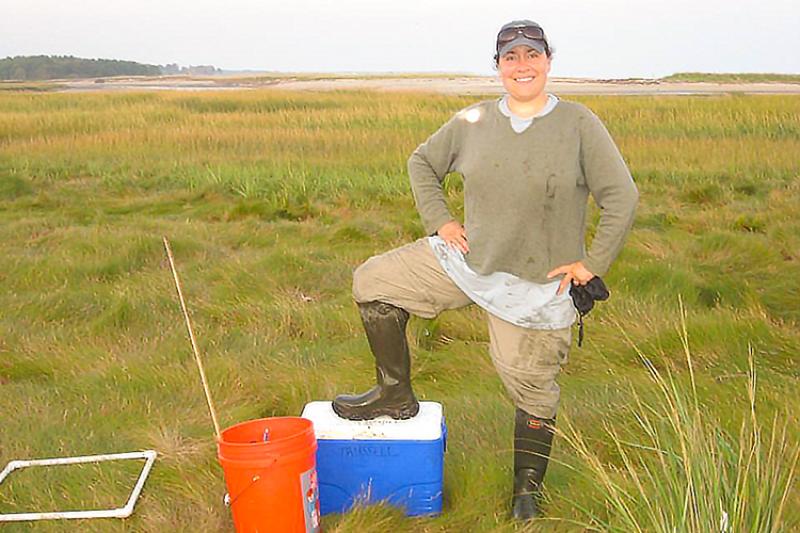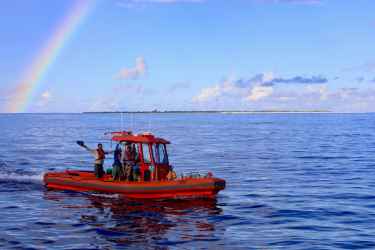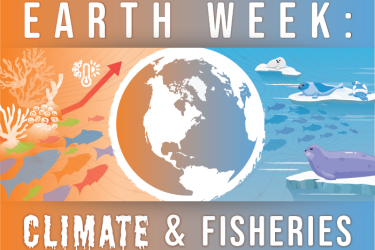March is Women's History Month. To celebrate, we're showcasing some of our colleagues who contribute to NOAA Fisheries' core missions every day. Learn more about their career journeys, day-to-day jobs, and what Women's History Month means to them.
Women of NOAA Fisheries
Meet Communications Specialist, Meaghan Emory
Meaghan shares her experience growing up that led her to her current job as a communications manager for NOAA’s Southeast Fisheries Science Center.
Meet Biological Science Technician, Kristin Hannan
Kristin shares her background, what she enjoys most about working for the Southeast Fisheries Science Center, and her advice for anyone interested in a career at NOAA Fisheries.
Talking with Dvora Hart
Dvora is an operations research analyst and lead assessment scientist for the Northeast Fisheries Science Center. We spoke with her about her love for the natural world and mathematics and her work in fisheries and mathematical biology.
Talking with Megan Amico
Megan Amico is the gear researcher and fish biologist for the Northeast Fisheries Science Center. She collaborates with commercial fishermen to explore and evaluate on-demand gear that could reduce North Atlantic right whale entanglements. She also evaluates the use of a low-profile gillnet to reduce sea turtle bycatch and supports white shark research through passive acoustics.
Talking with Angela Silva
To celebrate Women’s History Month, Angela talks about her science journey, what shet loves most about her job, and what advice she has for the next generation of women scientists.
Meet Research Associate, Erin Pickett
Erin grew up in Hawai'i on the island of Kauaʻi and spent most of her childhood in and on the water. She shares the story of her career path, which spanned a few oceans and a multitude of marine species leading up to working at the Southeast Fisheries Science Center.
Learn about Erin Pickett and her work
Meet Research Ecologist, Skyler Rose Sagarese
Skyler reflects on her childhood love of sharks and family vacations to the Florida Keys, which led her to pursue a career working at our Southeast Fisheries Science Center.
Learn more about Skyler Rose Sagarese and her work
Joy Merino, Fisheries Biologist
Joy earned a Master’s of Biology from University of Louisiana where she studied seagrass and wetland ecology. Before that, she double majored in anthropology and philosophy with a minor in geography at Illinois State University in Normal, Illinois.
Her work spans social science, tribal engagement, habitat, strategic planning, and more.
Learn more about Joy Merino and her work
Gillian Phillips, Community Ecology Technician
Gillian Phillips is a community ecology technician and deckhand for the Northeast Fisheries Science Center’s Aquaculture Systems and Ecology Branch. She’s a member of the GoPro Aquaculture Project team that uses GoPro video cameras to study how fish use aquaculture gear like oyster cages as habitat. Gillian works with a field team to collect the underwater video and then counts fish and documents fish behaviors around the oyster cages and natural rock reef habitats. Her home base is at our Milford Laboratory in Milford, Connecticut.
Learn more about Gillian Phillips and her work
Dr. Katherine Bemis, Research Zoologist
Dr. Bemis is a Research Zoologist with the National Systematics Lab, where she studies marine fishes. Her passion for fisheries biology started young and runs deep—she first started working with NOAA Fisheries researchers when she was just a high school student! As an undergraduate student, she was selected for the Ernest F. Hollings Scholarship and had the opportunity to work on a research project in the National Systematics Lab, which would help to pave the way for her eventually joining the lab as a full-time research zoologist after completing her Ph.D. at the Virginia Institute of Marine Science.
Learn more about Katherine Bemis and her work
Gabrielle Clardy, Groundfish Program Assistant Area Lead
As the groundfish program assistant area lead for the Northeast Fisheries Science Center’s Fisheries Monitoring and Operations Branch, much of Gabrielle Clardy's work focuses on planning, coordinating, and executing at-sea monitoring coverage in the Northeast by working with sector managers and fishery monitoring service provider companies. Her home base is at the Tech Park facility in Falmouth, Massachusetts. Gabrielle attended Old Dominion University in Norfolk, Virginia, earning a Bachelor's degree in Marine Biology and then interning in one of the University labs that collected harmful algae bloom samples for the Virginia Department of Environmental Quality. She went on to become a fisheries observer in the Southeast, working on longline fishing vessels observing for large pelagic species. Later, Gabrielle also became a protected species observer, a dockside interviewer, and a large pelagic surveys sampler.
Learn more about Gabrielle Clardy and her work
Dr. Martha Nizinski, Research Zoologist
Dr. Nizinski is an expert on deep-sea coral communities and Research Zoologist with NOAA’s National Systematics Laboratory. In 2011, she spearheaded the NOAA Deep Sea Coral Research and Technology Program’s Northeast Initiative. By 2015, Nizinski had helped to lead successful research cruises visiting more than 30 underwater canyons to collect critical data on deep-sea coral communities. Nizinski has made such a splash in her career that she even has a species of sea star named after her: Evoplosoma nizinskiae.
Learn more about Dr. Nizinski's work
Dr. Dionne Hoskins-Brown, Fishery Biologist
Dr. Hoskins-Brown, a fishery biologist at the Southeast Fisheries Science Center, is an expert in benthic invertebrate ecology. She conducts research on fisheries habitat with students at Savannah State University, where she got her undergraduate degree in marine biology. She and her students have researched the distribution of blue crab populations in Georgia tidal creeks, marsh dieback, and success in oyster reef restoration, as well as the human dimensions of fisheries and the connection to the local community.
Learn more about Dr. Hoskins-Brown's work
Sarah Bland, Deputy Regional Administrator
Sarah Bland is the Deputy Regional Administrator for the Greater Atlantic Regional Fisheries Office and responsible for overseeing internal operations, including personnel and human capital management and organizational excellence. She also provides programmatic guidance for sustainable fisheries, protected resources, habitat conservation, and administrative activities.
Bland developed a love and passion for the ocean and seafood because of her family and summer vacations in Florida, Maine, and Alaska with her grandparents. She says she fell in love with manatees during a trip to Florida in grade school and decided to become a marine biologist. From there, her curiosity and passion for the ocean and the marine environment began, and ultimately led her to a career in sustainable fisheries and to NOAA.
Learn more about Sarah Bland and her work
Ann Petersen, Fisheries Biologist
Ann Petersen is a fisheries biologist for the Northeast Fisheries Science Center’s Fisheries Ecology Branch. She studies the effects of climate change, pollution, and habitat loss on the health of fish and fish populations. Her home base is at our James J. Howard Marine Sciences Lab in Highlands, New Jersey.
Petersen has had a life-long obsession with the outdoors and originally majored in biology at the University of Arizona. She enjoyed learning about the desert, mountains, and forests there, but her first time scuba diving was life-changing. Soon after, she transferred to Eckerd College where they have a strong marine science program.
She's grateful to have experienced that first dive as an impressionable 19 year old and that she's been able to study fish ever since.
Learn more about Ann Petersen and her work
Dr. Abigail Reft, Cnidarian Expert and Museum Specialist
Dr. Reft is a a cnidarian expert and Museum Specialist for the National Systematics Lab. She helps manage the marine fish collection housed in the Smithsonian's National Museum of Natural History. Reft had a fascination with the natural world from a young age, and through her undergraduate studies became completely enamored with cnidarians, a group of aquatic organisms that includes certain species of jellies, sea anemones, and corals. At the systematics lab, she enjoys microscope work, where she can really investigate these organisms up close.
Learn more about Dr. Reft and her work
Genevieve Bernatchez, Physical Science Technician
Genevieve Bernatchez is a physical science technician for the Northeast Fisheries Science Center’s Aquaculture Sustainability Branch. She runs chemical and biological analyses critical to shellfish aquaculture and environmental research. Her home base is at our Milford Lab in Milford, Connecticut. In her position, she works on different projects and with different teams and is in charge of analyzing most of the water chemistry samples at the lab. Currently, she is working on a project looking at the effects of ocean acidification on multigenerational bay scallops.
She completed an undergraduate at the University of Quebec a Rimouski and also holds a master’s degree in science, specializing in marine ecology, from Northeastern University.
Learn more about Genevieve Bernatchez and her work
Ellie Hartman, Communications Intern
As an intern at the Southeast Fisheries Science Center, Ellie Hartman works with the communications team to take the diverse complexity of science communications and translate it into language that the public understands. Each day she takes the hard work of scientists at the center and shares it with stakeholders and the public. She and other members of the communications team tackle this through talking with colleagues, creating web stories, social media posts, blogs, fact sheets, story maps, website updates, and other digital communications.
Ellie attended Barry University in Miami Shores, Florida and was captain for two NCAA rowing Championship golds. There she earned an undergraduate degree in Business Management and then a Masters of Business Administration degree, with an emphasis in management and marketing. She also has a Masters of Professional Science degree in Marine Conservation from University of Miami's Rosenstiel School of Marine, Atmospheric, and Earth Sciences.
Learn more about Ellie Hartman and her work
Erica Rule, Chief of Staff for Science Planning and Operations
As the Chief of Staff for Science Planning and Operations at the Southeast Fisheries Science Center, Erica Rule supports the leadership of the center by making recommendations and providing timely and informed guidance in support of the center's mission. She helps ensure success of the center’s recent realignment and leads the evolving strategic planning process, aligning the strategic objectives and initiatives with budget planning and execution. She coordinates with the Operations, Management, and Information Division to implement the annual budget planning process, Priority Based Resourcing, and ensure effective allocation of resources in alignment with annual guidance priorities.
Erica earned a Bachelor’s of Science in Biology from Mary Washington College (now the University of Mary Washington) in Fredericksburg, Virginia. She also has a Master’s of Science in Marine Affairs and Policy from the University of Miami Rosenstiel School for Marine, Atmospheric, and Earth Science.
Learn more about Erica Rule and her work
Changhua Weng, Social Scientist
As a social scientist for our Northeast Fisheries Social Sciences Branch, Changhua works on developing social indicators of fishing community vulnerability and resilience to changing fishery management and climate conditions like sea level rise and storm surge. Her recent work involves a national effort to update community snapshots for fishing communities across all regions within NOAA Fisheries. Her home base is at our Narragansett Lab in Narragansett, Rhode Island.
Changhua went to Fujian Normal University to study environmental science and received her bachelor’s degree, and later a master’s degree in environmental management at Xiamen University. She started her doctoral degree in Marine Affairs at the University of Rhode Island looking at nonpoint source pollution control and policy for a watershed in southeastern China. Two years into her doctoral degree, she interned for a summer with the science center’s Social Sciences Branch working with anthropologist Dr. Lisa Colburn. Changhua studied job satisfaction and social well-being in fishing communities, which turned into a full-time job focusing on the development of community social vulnerability indicators in coastal fishing communities.
Learn more about Changhua Weng and her work
Sarah Williamson, Fisheries Observer
There are many paths that can bring a person to the deck of a fishing vessel in the frigid waters of the Bering Sea. For fisheries observer Sarah Williamson, that path included a lifelong love of the ocean and a nudge from a social media post. After earning her bachelor’s degree in marine biology, she was bouncing between veterinary nursing jobs when she decided to pursue a job as a fisheries observer. Since the summer of 2016, Williamson has spent about 150 to 220 days annually at sea. She typically works in the catcher-processor fleet, which targets species including pollock, flatfish, and rockfish. She has also worked in the At-Sea Hake Observer Program run through the Northwest Fisheries Science Center, along with taking part in halibut surveys on longline vessels.
Williamson’s scientific knowledge and horizons have also expanded through her work as an observer. She has participated in several research trips and worked on special projects, such as sorting marine debris. She was recently selected as the observer representative for the North Pacific Fishery Management Council’s Fisheries Monitoring Advisory Committee. She looks forward to continuing to grow her skills through observing.
Learn more about Sarah Williamson and her work
La'Shaun Willis, Museum Technician
La'Shaun Willis is a Museum Technician with the National Systematics Laboratory, where she supports research activities and helps to manage the Smithsonian's marine fishes collection. Willis knows that the narratives that we tell ourselves and others about careers in science, technology, engineering, and mathematics (STEM) matter, which is why she now dedicates much of her time to conducting outreach with local school groups and making science more accessible to students.
Learn more about La'Shaun Willis and her work
























